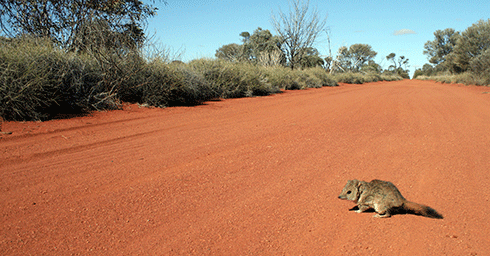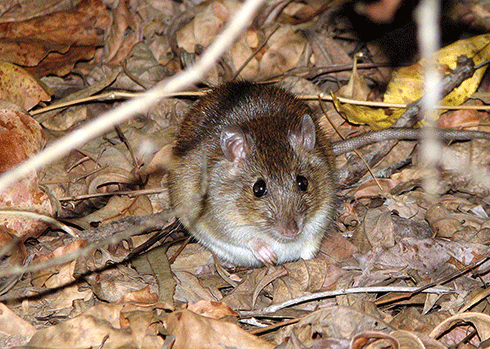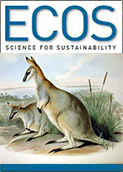
|
Published: 10 June 2014
Much loss and an uncertain future for Australia’s unique mammals
Australia’s mammal fauna is the most distinctive of any continent. It includes many species and groups of remarkable antiquity. At the time of European settlement, many Australian mammal species were extraordinarily abundant, and many had pivotal ecological roles.
We now see only a faint shadow of this richness and abundance. Over the past two centuries, our mammal fauna has collapsed to a greater degree than any other plant or animal group. This degree of loss is far more than that reported for mammal fauna in any other continent over the same period.
What have we lost? Why did it happen? Is it still happening? And, what can we do?
These questions prompted a recently completed review of the conservation status of the entire Australian mammal fauna: The Action Plan for Australian Mammals 2012.
The review incorporated input from more than 200 scientists with expertise in Australian mammal species.
The results are disconcerting. The review concluded that 29 mammal species – of which 28 were endemic – have become extinct in Australia over the last 200 years. This tally represents more than 10 per cent of the pre-European endemic terrestrial mammal fauna, and is notably higher than previously recognised.
While almost all Australians know of the extinction of the thylacine, few could name more than one or two other losses. These include the lesser bilby, toolache wallaby (described by early observers as ‘the most beautiful and elegant of all the wallabies’), desert bettong, long-tailed hopping-mouse, crescent nailtail wallaby and pig-footed bandicoot.
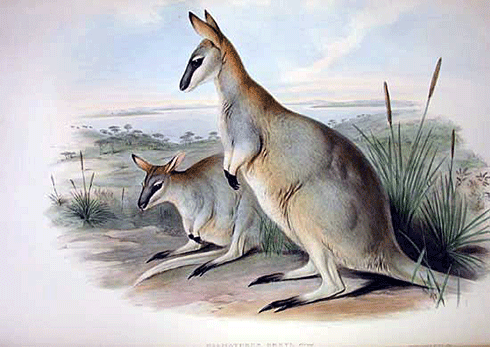
|
|
The extinct toolache wallaby, Macropus greyi, once described as ‘the most beautiful and elegant of all the wallabies (depicted here by John Gould). Credit:
Wikimedia Commons under CC-PD-Mark 1.0
|
Many factors have contributed to these extinctions. But, the primary causes are different from the main factors – habitat loss and hunting – driving biodiversity loss elsewhere. In Australia, the most pervasive cause of decline and loss of terrestrial mammals has been predation by introduced cats and foxes, often exacerbated by inappropriate fire regimes. Much of the loss has occurred in remote and less modified parts of Australia.
This susceptibility to introduced species is a characteristic of island biodiversity. Australia’s isolation resulted in its remarkably distinct biodiversity, as well as the extraordinary vulnerability of its biota to new threats.
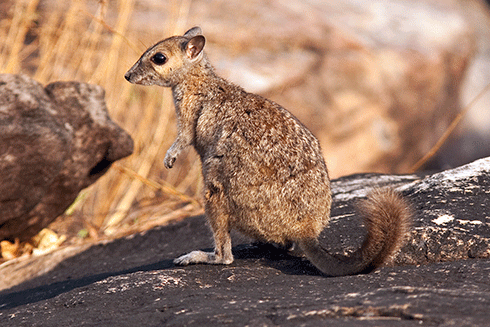
|
|
Little is known about the ecology of Australia’s smallest wallaby, the monjon, restricted to parts of the Kimberley. Credit:
G. Dutson
|
Australian mammal extinctions have not abated in recent years. Rather, they have continued at more or less the same rate since the first post-European extinction in about the 1840s. The most recent recognised Australian mammal extinction was of the Christmas Island pipistrelle, in 2009; but it is likely that another species, the Bramble Cay melomys, has since been lost as well.
The review categorised 55 terrestrial endemic mammal species as threatened (Critically Endangered, Endangered or Vulnerable), representing more than 20 per cent of Australia’s terrestrial mammal fauna.
Unless declining trends are stabilised or reversed, many more threatened terrestrial and marine species are likely to become extinct in our lifetime.
The decline and loss of the Australian mammal fauna has gone largely unrecognised by most Australians. This may be because many terrestrial species are small, unobtrusive and nocturnal, and many marine species live hidden from our view in distant waters.
Few Australians have seen or even know of the dibbler, itjaritjari, kowari, kultarr, mulgara, mala, warru, ningaui or nabarlek. Without knowledge of, or affinity for, our wildlife, our society will value it little and will not care enough about its fate.
Many Aboriginal Australians had an extraordinarily detailed knowledge of these species. For them, the connection was deeply spiritual – as well as providing food, these animals were totems, which helped craft the place of individuals in country, and were instrumental to culture and law. Aboriginal Australians recognise a long-unbroken and important responsibility to ensure the maintenance of these species as part of a broader obligation to look after country. Many of these people are deeply affected by the losses. Biodiversity conservation in Australia is likely to continue to falter until our society absorbs some of the Indigenous connection to, and responsibility for, country.
Obscure species are not the only ones being lost. Even some of the most conspicuous and iconic elements of our fauna, including the koala and platypus, are in trouble. The Mammal Action Plan considers that the platypus now qualifies as ‘Near Threatened’. Its plight reflects much of our disregard for our country, and the consequences of this disregard.
The platypus is declining as we allocate its waters, as our global activities increase the likelihood of extreme drought, as cats and foxes take their toll, and as irresponsible fishing practices trap and drown them. Discarded plastic and rubbish entangles the platypus; agriculture, industry and exotic fish pollute their watercourses; and an obscure fungal disease, probably introduced accidentally by humans, peels their skin from them.
The near-threatened state of the platypus is symptomatic of the medley of local, regional and global threats by which, almost heedlessly, we abuse our natural world.
However, there is still hope. Amid the general current trend for decline, the Mammal Action Plan notes and celebrates some remarkable success stories. With long-term commitment of strategic management actions, some species such as the boodie and bridled nailtail wallaby, once doomed to extinction, are now gradually increasing within fenced-off areas free of cats and foxes (most such areas are managed by the Australian Wildlife Conservancy). The cessation of whaling and sealing, and some tighter regulation of fishing activities, has also led to recovery of some marine mammals including the humpback whale.
Such cases demonstrate that our fauna is not an effete set of hopeless cases. Rather, given adequate management of threats, some near-lost species are now increasing. We have both the opportunity and capability to prevent further extinctions of Australia’s mammal fauna.
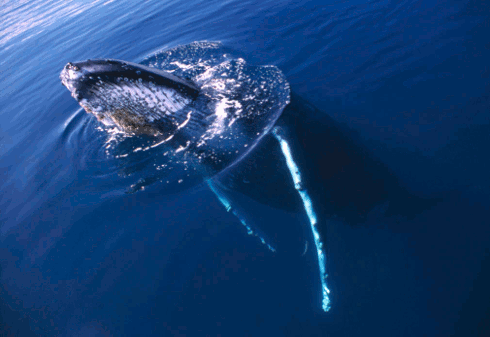
|
|
Humpback whale populations have also recovered, providing further hope for the future. Credit:
Peter Harrison
|
Some scientists have argued that our community should abandon such an objective, and instead direct the limited available resources to conserving only those species that are most valued or most cost-effective to protect. The remaining species, it is argued, which are too marginal or expensive to care about, should be discarded as ‘living dead’.
Given its history and ongoing trend of decline, Australia’s mammal fauna is likely to be at the forefront of this debate. We have lost more than enough of our natural heritage: to fit into this land, our society must accept a more substantial responsibility for its unique heritage.
Broadly, we conclude that ten steps are necessary for this future:
-
As a society, we need to reassess what it means to live in this land and manage its seas, and to accept more responsibility for custodianship.
-
For conservation to work effectively, our community needs a greater affinity for, and connection with, our wildlife.
-
We need to recognise and draw inspiration and confidence from cases of conservation successes and recovery.
-
Extending from a baseline of government obligation and clear accountability, conservation must be a shared responsibility.
-
We need to recognise that the effort we are currently making is insufficient to manage effectively the many now deeply entrenched threats.
-
For conservation of Australian terrestrial mammals, most gain will come from the effective broad-scale control of feral cats and foxes.
-
We need to establish and maintain a set of conservation nodes where threats and threatened species are intensively managed.
-
Such nodes need to be complemented by broader (landscape and seascape-scale) coordinated management. Indigenous Protected Areas provide a notable contribution.
-
Although current information provides a reasonable basis for assessing conservation status and priorities for management of most species, there is a pressing need for more knowledge about many ‘Data Deficient’ species, particularly for most marine mammals.
-
We must improve the effectiveness and integration of monitoring biodiversity status and its key threats, and of the response of threatened species to our management.
John Woinarski has been involved in research, management, advocacy and policy relating to biodiversity conservation since the 1970s. He is currently a Professor in the Research Institute for the Environment and Livelihoods, Charles Darwin University, and within the North Australian Hub of the National Environmental Research Program (NERP). Andrew Burbidge is a former research scientist and manager with the Western Australian government who has worked as a consultant conservation biologist since 2002. Peter Harrison is Professor and Director of the Marine Ecology Research Centre at Southern Cross University. The Action Plan for Australian Mammals can be ordered online here.


